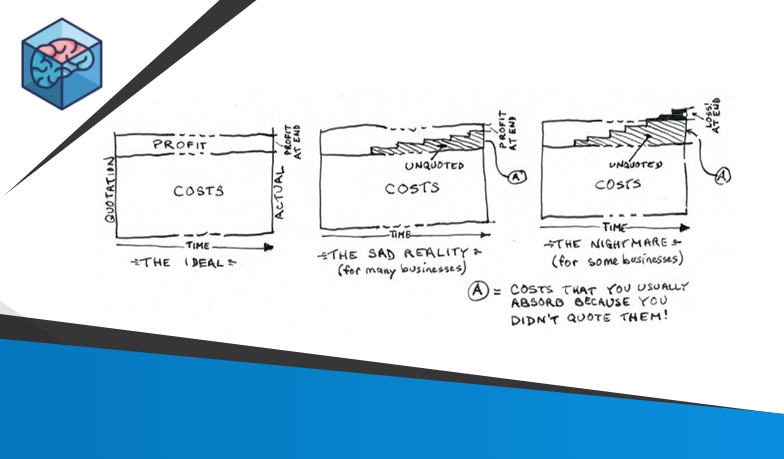BUT…
The price and THE PROFIT are now SET IN STONE. You can’t make any more profit than the profit already in your quote. Hmmm… Did you actually consider every item that should be in the quote? Did you review the profitability in the quote? Was it acceptable? Will you need to rely on variations to cover the items you left out? Will you be one of those businesses which rely on the kick-off payment from the next job to finish off the previous job?
A couple of years ago I was working with a company that specialises in office maintenance. They would instal data projectors, AV systems and cabinetry in office buildings. We had just finished mapping the process to kick off a new project – it was the last process we mapped and of course we were pleased to get it finished. It was pretty much time for a group hug and a high-five and we were feeling like we’d really achieved something.
It’s always worth a second look
Then I looked at this one, seemingly insignificant little single step – Prepare a quote. Just one little step in the process. Looking at it, I remembered one of the guys mentioning the extra cost they incurred on a job because they needed to use a contractor instead of one of their staff trades. I realise that we’d put way too little effort into THE MOST IMPORTANT PROCESS IN THE BUSINESS! The champagne definitely had to go back into the fridge.
We then listed all the variables that should have been considered in the quote process. Things such as:
- Staff trades versus contractors
- Specialist skills or requirements?
- Site visit/check measure required – yes or no?
- Constraint on the hours we can work on the site?
- Any rules about street access times or booking?
- Site induction required?
- Noise or dust management required?
- Security cards or keys needed?
… and the list went on for another ten or so items.
That one little step “Prepare a Quote” had the potential to make or break the profitability of the project. It was so very important.
Time to update the systems
We mapped the new quotation process, this time allowing for all the variables we’d listed, ending up with around 20 steps in the process. Not that we wanted to make the process more complex, but we definitely wanted to make sure that the quote would cover everything we needed to cover. We wanted to make sure that the profit we had in the quote when the client signed off ended up being the profit we put in the bank at the end of the project – the ideal quote.
Looking at the final process, we had that sense of satisfaction that comes when you know you’ve done something well. We knew that we had done everything we could to PROTECT THE PROFIT!
We actually used that phrase, “Protect the profit” and the business owner jokingly considered changing business card titles to include ‘Profit Protector’ for everyone in the team. Not a bad thought.
The proof is in the Profit
Taking the extra time to delve into the quotation process paid off for this client, just as it would pay off for every other business owner. It is definitely best practice to consider all the variable factors in the job from the project management perspective. But you are only going to be paid for these variables if they’re in the quote. And remember, if the client isn’t paying for these things, you are.
Learning from this true story it’s easy to see the importance of carefully considering all the variables and all the risks that are in a process before you map it or write it down. Then you can check the final draft against all the variables and risks to make sure that your process has managed every one of them. Any variables or risks you haven’t managed are still sitting in that process waiting to bite you when you least expect it.
The time we spent to map out the process with focus is being repaid with every quote sent. That’s the way it is with great systems.
⚙
John Tonkin is the founder and Director of Brain in a Box Pty Ltd. Working with businesses to improve or formalise the systems that underpin their success is what Brain in a Box does.

